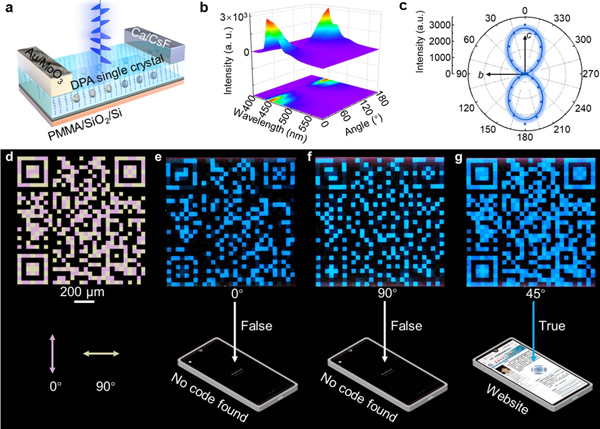Researchers Develop Organic Polarized Light-Emitting Transistors
Polarized light sources are central to various applications including bio-navigation, anti-glare display, encrypted transport, optical communication and 3D display. Controlling polarized emission from a light-emitting diode has received growing interest from both academia and industry with the invention and rapid development of organic light-emitting devices (OLEDs). However, the unique microcavity in sandwich light-emitting diodes imposes difficulties for directionally polarized light emission. Moreover, in most cases, they still suffer from requirements to integrate additional polarizers or build complex nanostructures (such as metal gratings and photonic crystals). Organic light-emitting transistors (OLETs) combining the light-emitting function of OLEDs and the current modulation (and amplification) function of organic field-effect transistors (OFETs) in a single device have great potential for integrated optoelectronics and smart display technologies. The open-ended light-emitting properties of OLETs are accessible for the investigation of light-matter interactions in organic semiconductors, providing a platform to generate and modulate polarized emission by gate voltage.
In a study published in Advanced Materials, A research group led by Prof. DONG Huanli from the Institute of Chemistry of the Chinese Academy of Sciences (ICCAS) constructed and developed highly efficient optoelectronic integrated devices, organic polarized light-emitting transistors (OPLETs). They also developed a method for determining the axis of single crystals of luminescent molecules by polarized fluorescence. The researchers demonstrated through theoretical calculations and complete experiments that the high polarization properties arise from the intrinsic in-plane anisotropy of the molecular transition dipole moment and open-ended luminescence characteristics.
2,6-diphenylanthracene (DPA) single crystals with high mobility and strong luminescence are chosen as the active layer of OPLETs. The high polarization property of OPLETs with a DOP as high as 0.97 is proved, which is comparable to completely linearly polarized light (DOP = 1). The polarization characteristics of the OPLETs devices are very stable during testing independent of gate voltage, crystal thickness, and conductive channel direction. The practical usability of OPLETs devices is conferred by these characteristics. They apply OPLETs as a light source for imaging and anti-counterfeiting security, the brightest and darkest capital letters or logos can be imaged at polarization angles of 0° and 90°, respectively. OPLETs are used for modern anti-counterfeiting security because of their different luminous intensity at different angles. The information in the quick response (QR) code can only be verified if it is illuminated by a polarized light source at a specific angle, which will further improve the security of the QR code information.
The researchers believe that this work would establish a new research direction for developing miniature and integrated polarized light sources for advancing potential applications of various on-chip microelectronic and photonic.

Polarized Organic Light-Emitting Transistors and Their Security and Anti-counterfeiting Applications (Image by QIN Zhengsheng)
Contact:
Prof. DONG Huanli
Institute of Chemistry, Chinese Academy of Sciences
Email:dhl522@iccas.ac.cn
| Download the attachment: |





